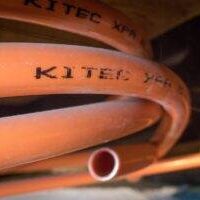Kitec Plumbing Info
What is Kitec?
Kitec was produced by a Canadian manufacturer, IPEX. Kitec plumbing consists of flexible aluminum pipe between an inner and outer layer of plastic pipe (PEX pipe) with brass fittings. Marketed as a cheaper and easy-to-install alternative to copper piping, Kitec was sold between 1995 and 2007 putting homes built or extensively remodeled during this period at risk.
How to identify Kitec Plumbing…
Most Kitec plumbing can be identified by its bright orange (hot water) and bright blue (cold water), which were the most common colors; however, it was also sold in red, blue, gray and black.
The pipe is typically marked with one of the following brand names; Kitec, PlumbBetter, IPEX AQUA, WarmRite, Kitec XPA, AmbioComfort, XPA, KERR Controls or Plomberie Améliorée. If fittings are visible, look for Kitec or KTC stamped on them. The terms CSA B137.9/10 or ATSM F1974 could also indicate a Kitec system. Often, the best place to look for the Kitec system is near the hot water tank or in the mechanical room where the pipe connects or exits the walls. Also look under Orange ‘’hot water’’ and blue ‘’cold water’’ Kitec pipes Kitec brass crimp fittings Kitec electrical panel sticker kitchen sinks or bathroom vanities, where the pipe and/or fittings exit the wall. Look at the electrical panel doors, both inside and out, for a bright yellow or neon colored sticker stating that Kitec was used in the home and that the electrical system cannot be grounded to it (electrical systems must have a metal ground).

The Problems with Kitec…
ONE…
The brass fittings specific to Kitec plumbing are made with an extremely high zinc content and have been banned in the US as a result. This high zinc content results in dezincification and corrosion with prolonged exposure to water, causing build up in the fittings, decreased water flow and high potential for total failure of the fitting. All cases can result in extensive leaks in the plumbing causing water damage, rot and mold.
TWO…
While Plastic Piping, or PEX, is favored among most plumbing companies because of its flexibility, durability and ease of install for new houses and remodels - PEX is not to be confused with Kitec. Kitec piping uses two layers of PEX, but adds a layer of aluminum to make the piping which was meant to make it stronger and more manageable. The problem, however, is that the aluminum used is only certified to run at a maximum temperature of 180°F. With the average water heater running at 170°F, and varying from there, the high temperatures cause the aluminum to disintegrate reducing the integrity of the piping. This causes movement in the pipes resulting in breaks, kinks, holes and loosening at the fittings. All cases can result in extensive leaks in the plumbing causing water damage, rot and mold.
When working with homebuyers...
If your buyer is looking at homes that may have Kitec systems,
- Explain what Kitec plumbing is, that it may exist in the homes being viewed, and what the potential risks are, i.e. the fittings may fail, the pipes may fail, and there may be insurance and/or financing implications.
- Recommend having the home inspected by a qualified home inspector and raise Kitec concerns with the home inspector.
- When writing an offer, add a clause or clauses to the agreement inquiring into the existence of Kitec plumbing and ensure the clause makes provisions for the buyer should the house have a Kitec system.
Traditionally, similar clauses have been written for for Urea-formaldehyde foam insulation (UFFI) and asbestos. While industry members may be able to identify Kitec plumbing, this should not replace the recommendation that a customer obtain a home inspection.
When working with sellers…
If you are working with a seller and there is Kitec plumbing in the home, it is important to discuss the potential issues that may arise with Kitec that may affect the sale as well as recommend your seller obtain independent legal advice about Kitec at their earliest opportunity.
As of publication of this article: In most cases, Kitec is visible upon inspection and therefore not considered a material latent defect—a defect that is not visible or discoverable through a reasonable inspection. Kitec does not have to be disclosed on the PCDS unless the seller has experienced problems with the system. If the seller has experienced problems with the Kitec system, it must be disclosed on the PCDS.
While at this time, there is no requirement for mandatory disclosure for systems in good working order, if a potential buyer asks about the existence of Kitec in the home, it must be disclosed. Kitec is the subject of a $125 million class action suit in Canada and the United States and the topic of many news stories over the last six years. The first recall on Kitec fittings occurred in 2005. It is reasonable to expect buyers to be aware of and to make inquiries about the existence of Kitec, so it is important to set expectations with sellers. Even if the seller has never experienced a problem with their Kitec system, it may be an issue for potential buyers. If it is, buyers may request a price reduction, or system replacement, or wish to terminate the transaction.
Your seller may or may not be aware of the Kitec class action settlement, which creates a $125 million settlement fund to be used by Canadian and American claimants to pay for the repair of buildings, residences, homes or other structures plumbed with Kitec systems. To be eligible to receive money from the settlement fund, claimants must complete and submit a claim form. Claims can be made regardless of loss and individuals are encouraged to submit a claim even if their system is working properly. The claim filing deadline is January 9, 2020, and claims submitted after this date will be rejected. If your seller submits a claim, they are required to disclose to potential buyers that a claim was filed and if applicable, the terms of the release (as disclosed in the Agreement).
For more information, see the Kitec Settlement website at the following link: http://www.kitecsettlement.com/faq.cfm
The laws regarding the disclosure of information to potential buyers and/or subsequent owners vary depending on the state or province. If you are planning on selling your home and have a Kitec System, or purchasing a home that may have a Kitec System, you should consult with a real estate lawyer in this regard.
